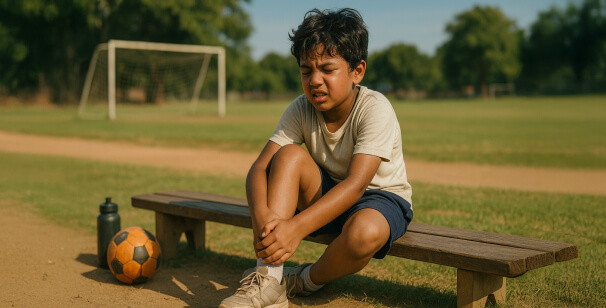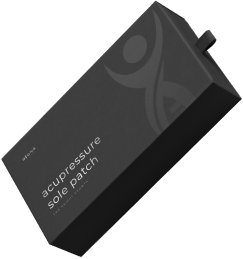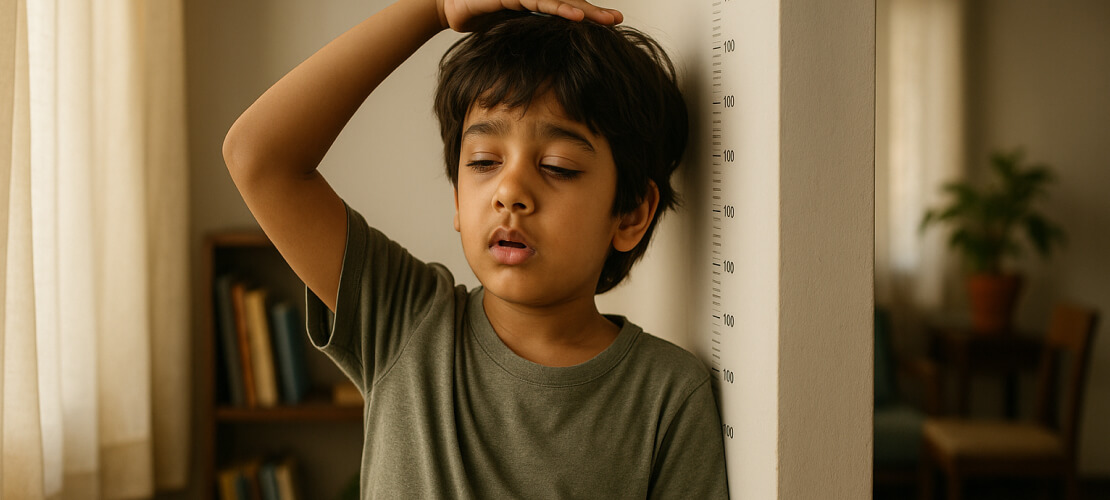Table of Contents
SHARE IT ON
Being in the early childhood phase, health is a crucial period for kids. Growth is considered not only by genes but also by habits, surroundings, diet, and sleep. Quite frequently, parents tend to focus on the diet and proper workout, but they may overlook the lifestyle habits that weaken their child’s growing capabilities. Understanding these growth-stunting habits in children is essential for ensuring healthy development.
In 2025, according to the World Health Organization (WHO), 148 million children under five are affected by stunting globally. While poverty and food insecurity are major contributors, many middle- and high-income families unknowingly encourage behaviours that hinder optimal growth. Here’s how to recognise and address them.
1. Sleep Deprivation: A Silent Growth Killer

The “Growth hormone” (GH), which is the primary factor in the growth of bones and the development of muscles, is mainly secreted during deep sleep. GH deficiency caused by insufficient sleep directly affects the height of a person.
Data Insight (2025)
“A global survey, documented in 2025 and printed in the Journal of Economic Surveys, uncovered that kids aged 6-12 who slept below 8 hours nightly were 22% more likely to have low height-for-age measures in contrast to the 9-11 hours group.”
Common causes of poor sleep in kids height include:
- Irregular bedtime routines
- Excessive screen time before sleep
- Overstimulation and caffeine consumption
- Lack of physical wind-down activities
Sleep deprivation also increases cortisol (stress hormone), which can inhibit GH release and delay puberty.
2. Backpacks and Bones: Is Your Child Carrying Too Much?

Despite being indispensable tools, school backpacks often make their weight a major issue. If you carry more than 15% of your body weight in a backpack on your back, then certainly your posture will be poor, your spine not aligned, and you will have chronic back pain, all of which may not only be accompanied by but also hamper spinal growth.
Growth Impact:
- The suppression of the height may be caused by the spinal compression.
- The musculoskeletal system is affected when students use awkward positions and postures at the desk.
- The spine is subjected to long-term stress, imposing on it forces that may result in scoliosis of the post.
WHO also reported that in 2025, the exposed percentage of urban school-going children aged 64% exceeded the safe weight limit of the bag. Structural stress like this is the most overlooked and at the same time, one of the main causes of musculoskeletal pain and growth problems.
Fix It: Choose ergonomically designed backpacks with padded straps and encourage kids to carry only necessary items.
3. Too Much Training, Too Little Growth: When Exercise Becomes Harmful

Although it is important to remain physically active, overtraining among children, particularly in the realm of competitive sports, can be counterproductive. Excessive exercise may lead to an upsurge in cortisol that can halt the secretion of GH and compromise tissue repair.
Warning Signs:
- Constant fatigue
- Mood swings
- Poor appetite
- Frequent injuries
In 2025, a meta-analysis of young athletes found that children training more than 15 hours per week had 30% higher cortisol levels than those training less than 6 hours weekly. The elevated cortisol levels were linked with slower bone growth and delayed puberty onset.
The list of following list is made up of:
- 60 minutes of moderate activity daily is recommended by the WHO for children in general
- a minimum of one day of rest per week for young athletes
- well-planned workouts that are balanced and put recovery and rest time upfront
4. Junk Food Trap: How Processed Foods Addiction In Children Starves their Growth

The modern diet consumed by children is the main factor that contributes to the childhood malnutrition effects. It seems that kids can get the adequate calories they need, but they also are the ones who frequently lack the necessary nutrients.
Processed foods are:
- Lead to sugar, trans fats, and sodium
- Deficient in vitamins, minerals, and fiber
- Their hormonal system and immune reactions are one.
The regular use of junk food instead of nutritious meals is the cause of hidden hunger, the state of health in which kids are almost always well-looking but are very hungry inside.
According to the estimate of the World Health Organisation for 2025, about 38% of the children globally aged 5–15 take an ultra-processed diet daily and more than 50% of them experience a lack of vitamins, especially the trio of vitamin D, zinc, and iron that are so powerfully important for health and energy.
5. Screen Time and Growth Hormone: A Digital Dilemma

Continual exposure to the screen is a major factor in the disruption of circadian rhythms and melatonin release, which is then a key factor that, in one way or another, affects GH generation.
The results of long screen time are:
- Low sleep quality
- Deficient in vitamins, minerals, and fiber
- Increased time of sitting
- More eating
A report from 2025 says that children who regularly used screens for more than 3 hours per day had a decrease in GH secretion at night of 15–20% thus leading to an expected height percentile ranking decrease among their peers.
Final Thoughts
Growth isn’t just about adding inches, it’s about supporting the brain, bones, and emotional well-being. Identifying and reversing growth-stunting habits early can unlock your child’s full potential. Alongside a balanced lifestyle, many parents today also explore ways to support height growth supplement, using nutrient-rich diets and scientifically backed formulas.
Let’s raise children who stand tall not just in height, but in health.
FAQs
Common growth‑stunting habits include inadequate sleep, overloaded backpacks, overtraining in sports, high consumption of processed foods, and excessive screen time. These factors disrupt growth hormone secretion, spinal health, and nutrient absorption, even in genetically capable children.
Yes. Growth hormone (GH) is primarily secreted during deep sleep. Children sleeping less than 8 hours nightly show a significantly higher risk of low height-for-age measures compared to those getting 9–11 hours. Poor sleep also elevates cortisol, which further inhibits GH release.
Absolutely. Carrying more than 15% of body weight can compress the spine and lead to poor posture, chronic pain, and potentially hinder bone and spinal growth over time—even when children seem otherwise healthy.
Stunting in early life often causes irreversible height deficit, cognitive delays, poor school performance, and increased risk of chronic illness. Adults who were stunted in childhood tend to earn less and suffer greater health burdens.
Ensure consistent deep sleep, nutrient-rich diet with adequate protein, vitamins, and minerals, balanced physical activity, minimal processed food and screen use, and posture-friendly habits like ergonomic backpacks. Adequate hygiene, sanitation, and supplement use under guidance also help











